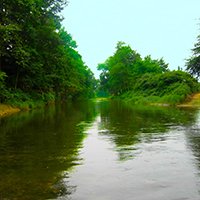Diatom communities and ecological status classification in the upper Po River basin

Submitted: 26 April 2021
Accepted: 7 June 2021
Published: 13 July 2021
Accepted: 7 June 2021
Abstract Views: 879
PDF: 358
Annex 1: 177
HTML: 88
Annex 1: 177
HTML: 88
Publisher's note
All claims expressed in this article are solely those of the authors and do not necessarily represent those of their affiliated organizations, or those of the publisher, the editors and the reviewers. Any product that may be evaluated in this article or claim that may be made by its manufacturer is not guaranteed or endorsed by the publisher.
All claims expressed in this article are solely those of the authors and do not necessarily represent those of their affiliated organizations, or those of the publisher, the editors and the reviewers. Any product that may be evaluated in this article or claim that may be made by its manufacturer is not guaranteed or endorsed by the publisher.
Similar Articles
- Chang-Chun Huang, Yun-Mei Li, Hao Yang, Qiao Wang, Jun-Sheng Li, Xia Chen, Underwater light field determined by water constituents in highly turbid water: the case of Taihu lake , Journal of Limnology: Vol. 72 No. 1 (2013)
- Tomasz Mieczan, Urszula Bronowicka-Mielniczuk, Ciliates in different types of pools in temperate, tropical, and polar climate zones – implications for climate change , Journal of Limnology: Vol. 81 (2022)
- Koenraad MUYLAERT, José Miguel SANCHEZ-PÉREZ, Samuel TEISSIER, Sabine SAUVAGE, Alain DAUTA, Philippe VERVIER, Eutrophication and its effect on dissolved Si concentrations in the Garonne River (France) , Journal of Limnology: Vol. 68 No. 2 (2009)
- Lei Zhang, Qianjiahua Liao, Chao Zeng, Qiongli Mo, Chengxin Fan, Effects of pretreatment on the sequential phosphorus fractionation of anaerobic sediment , Journal of Limnology: Vol. 73 No. 2 (2014)
- Long Ma, Jinglu Wu, Wen Liu, Jilili Abuduwaili, Distinguishing between anthropogenic and climatic impacts on lake size: a modeling approach using data from Ebinur Lake in arid northwest China , Journal of Limnology: Vol. 73 No. 2 (2014)
- Monika Tarkowska-Kukuryk, Wojciech Pęczuła, Tomasz Mieczan, Grazing affects periphytic algal biomass in the periphyton-macrophyte relationship independently of the substrate type and nutrient status , Journal of Limnology: Vol. 79 No. 2 (2020)
- Lucia Montes-Ortiz, Manuel Elias-Gutierrez, Faunistic survey of the zooplankton community in an oligotrophic sinkhole, Cenote Azul (Quintana Roo, Mexico), using different sampling methods, and documented with DNA barcodes , Journal of Limnology: Vol. 77 No. 3 (2018)
- Renata TREVISAN, Claudia POGGI, Andrea SQUARTINI, Factors affecting diatom dynamics in the alpine lakes of Colbricon (Northern Italy): a 10-year survey , Journal of Limnology: Vol. 69 No. 2 (2010)
- Livia Lucentini, Lilia Gigliarelli, Maria Elena Puletti, Antonella Palomba, Aurora Caldelli, Diego Fontaneto, Fausto Panara, Spatially explicit genetic structure in the freshwater sponge Ephydatia fluviatilis (Linnaeus, 1759) within the framework of the monopolisation hypothesis , Journal of Limnology: Vol. 72 No. 1 (2013)
- Anna B. Sikora, Piotr Dawidowicz, Eric von Elert, Daphnia fed algal food grown at elevated temperature have reduced fitness , Journal of Limnology: Vol. 73 No. 3 (2014)
<< < 32 33 34 35 36 37 38 39 40 41 > >>
You may also start an advanced similarity search for this article.

 https://doi.org/10.4081/jlimnol.2021.2025
https://doi.org/10.4081/jlimnol.2021.2025





